
The Toyota Celica is an automobile produced by Toyota from 1970 until 2006. The Celica name derives from the Latin word coelica meaning heavenly or celestial. In Japan, the Celica was exclusive to the Toyota Corolla Store dealer chain. Produced across seven generations, the Celica was powered by various four-cylinder engines, and bodystyles included convertibles, liftbacks, coupés and notchback coupés.
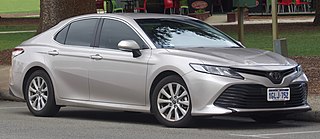
The Toyota Camry is an automobile sold internationally by the Japanese auto manufacturer Toyota since 1982, spanning multiple generations. Originally compact in size (narrow-body), the Camry has grown since the 1990s to fit the mid-size classification (wide-body)—although the two widths co-existed in that decade. Since the release of the wide-bodied versions, Camry has been extolled by Toyota as the firm's second "world car" after the Corolla. As of 2022, the Camry is positioned above the Corolla and below the Avalon or Crown in several markets.
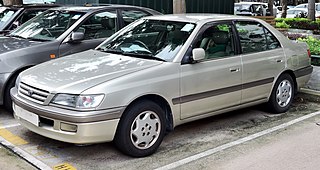
The Toyota Corona is an automobile manufactured by the Japanese automaker Toyota across eleven generations between 1957 and 2001. On launch, the Corona was Toyota's second-highest product in their range, just below the Crown. The Corona was marketed in the JDM at Toyota's Toyopet Store dealership channels, and the Corona was one of Toyota's first models exported to other global markets, followed by the smaller Toyota Corolla.
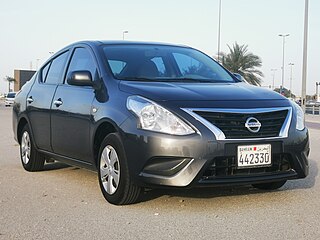
The Nissan Sunny is an automobile built by the Japanese automaker Nissan from 1966 till 2004. In the early 1980s, the brand changed from Datsun to Nissan in line with other models by the company. Although production of the Sunny in Japan ended in 2004, the name remains in use in China and GCC countries for a rebadged version of the Nissan Almera.

The Daihatsu Charmant is a subcompact sedan built by Daihatsu of Japan, based on the Toyota Corolla. It was succeeded by the Daihatsu Applause two years after Charmant production ended. The Charmant was heavily based on the E20 Toyota Corolla; model changes paralleled those of the Corolla. All Charmants were fitted with Toyota inline-four engines, ranging from 1.2 to 1.6 litres. The word charmant is French for "charming."

The Toyota Chaser is a mid-size car produced by Toyota in Japan. Most Chasers are four-door sedans and hardtop sedans; a two-door hardtop coupé was available on the first generation only. It was introduced on the 1976 Toyota Corona Mark II platform, and was sold new by Toyota at Toyota Vista Store dealerships only in Japan, together with the Toyota Cresta. The Chaser was produced for six generations, and production ceased in 2001, when it was merged with the Cresta to form the short lived Verossa.

The Toyota R family was a series of inline-four gasoline automobile engines. Designed for longitudinal placement in such vehicles as the Celica and Hilux and in production from 1953 through 1997, usage faded out as many of Toyota's mainstream models moved to front-wheel drive. Overhead cam (OHC) versions featured a chain-driven camshaft.
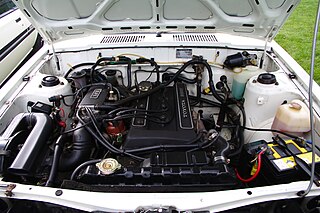
The Toyota T series is a family of inline-4 automobile engines manufactured by Toyota beginning in 1970 and ending in 1985. It started as a pushrod overhead valve (OHV) design and later performance oriented twin cam (DOHC) variants were added to the lineup. Toyota had built its solid reputation on the reliability of these engines.

The Toyota Mark II is a compact, later mid-size sedan manufactured and marketed in Japan by Toyota between 1968 and 2004. Prior to 1972, the model was marketed as the Toyota Corona Mark II. In some export markets, Toyota marketed the vehicle as the Toyota Cressida between 1976 and 1992 across four generations. Toyota replaced the rear-wheel-drive Cressida in North America with the front-wheel-drive Avalon. Every Mark II and Cressida was manufactured at the Motomachi plant at Toyota, Aichi, Japan from September 1968 to October 1993, and later at Toyota Motor Kyushu's Miyata plant from December 1992 to October 2000, with some models also assembled in Jakarta, Indonesia as the Cressida.

The Toyota Carina is an automobile which was manufactured by Toyota from December 1970 to December 2001. It was introduced as a sedan counterpart of the Celica, with which it originally shared a platform. Later, it was realigned to the Corona platform, but retained its performance image, with distinctive bodywork and interior — aimed at the youth market and remaining exclusive to Japanese Toyota dealerships Toyota Store. It was replaced in Japan by the Toyota Allion in 2001 and succeeded in Europe by the Toyota Avensis.

The Toyota Premio and its twin the Toyota Allion are sedans sold in Japan from 2001 to 2021 by Toyota. The sedans are designated as a compact car by Japanese dimension regulations and the exterior dimensions do not change with periodic updates. Unlike Toyota's other vehicles, the Premio and Allion are not exported, and are exclusively sold in Japan only. Size and pricing-wise, the E210 Corolla, introduced to the Japanese market in 2018 succeeds the Premio and Allion.
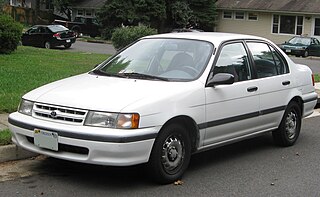
The Toyota Tercel is a subcompact car manufactured by Toyota from 1978 until 1999 across five generations, in five body configurations sized between the Corolla and the Starlet. Manufactured at the Takaoka plant in Toyota City, Japan, and sharing its platform with the Cynos and the Starlet, the Tercel was marketed variously as the Toyota Corolla II — sold at Toyota Japanese dealerships called Toyota Corolla Stores — and was replaced by the Platz in 1999. It was also known as the Toyota Corsa and sold at Toyopet Store locations. Starting with the second generation, the Tercel dealership network was changed to Vista Store, as its badge engineered sibling, the Corolla II, was exclusive to Corolla Store locations.

The Toyota Caldina is an automobile manufactured by Toyota for the Japanese market from 1992 to 2007. It replaced the Corona and Carina wagons, and was sold at Toyota Store and Toyopet Store locations in Japan. While the Caldina has never been officially exported by Toyota, its All-Trac 4WD capability and large capacity have made it a popular grey import in Australia, New Zealand, Russia and many South American countries. When it was discontinued in 2007, the T270 series Avensis wagon/estate assumed its market position.
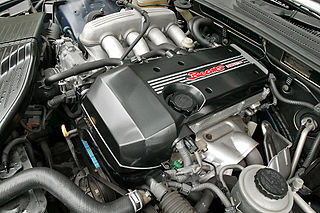
The Toyota S Series engines are a family of straight-four petrol engines with displacements between 1.8 and 2.2 litres, produced by Toyota Motor Corporation from January 1980 to August 2007. The S series has cast iron engine blocks and aluminium cylinder heads.

The Toyota Sprinter Marino is a four-door hardtop version of the Toyota Sprinter sedan produced between 1992 and 1998 for sale in Japan. The Toyota Corolla Ceres is a slightly restyled version of the Sprinter Marino, as was common practice by Japanese automakers in the 1980s and 1990s.
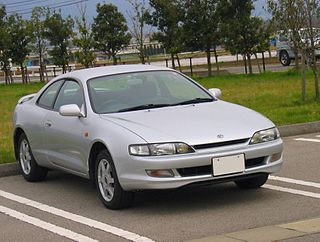
Most of the information in this article was translated from the Toyota Curren article on Japanese Wikipedia at ja:トヨタ・カレン.

The Corolla E70 was the fourth generation of cars sold by Toyota under the Corolla nameplate.

The Corolla E100 was the seventh generation of cars sold by Toyota under the Corolla nameplate. This generation of Corolla was larger, heavier, and visually more aerodynamic than the model it replaced. With its 2,465 mm (97.0 in) wheelbase, the Corolla had moved into the compact size class once occupied by the Corona and Camry. The Corolla again had an equivalent model Sprinter, with the Sprinter Trueno being equivalent to the Corolla Levin and both exclusive to Toyota Vista Store Japanese dealerships.
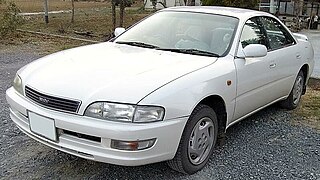
The Corona EXiV is an automobile manufactured by Toyota Motor Company. Released in 1989, it was the luxury hardtop version of the Corona and was introduced to emulate the twin Carina ED. The letters EXiV are derived from the words EXtra impressiVe. In Japan, the Corona EXiV was exclusive to Toyota Japan dealerships called Toyopet Store locations, and sold next to the Corona. The Corona EXiV and Carina ED share the same Toyota "T" platform as Celica. The Carina ED was exclusive to Toyota Store locations, and the Celica was exclusive to Toyota Corolla Store locations. When the EXiV was discontinued, the Toyota Progrès appeared for the market segment served by the EXiV.

The Toyota Carina line of large family cars was introduced in Japan in 1970. It was introduced in Europe in 1971, with A40 and A60 series subsequently appearing soon after their introductions in Japan. In 1984, the A60 series Carina was replaced in the European market by the "Carina II" - essentially a rebranding of the T150 series Toyota Corona launched the previous year in Japan, with some minor alterations to suit the European markets. This trend of Coronas rebadged as Carinas produced for the European market continued for two more generations, with the second Carina II in 1988 and the Carina E in 1992.



























